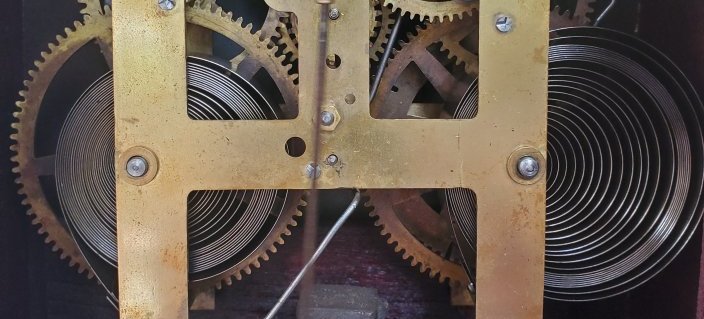You are in the clock tips set of pages.
- Exploring Your New Old Clock
- Winding Your Clock
- Is Your Clock Ticking Evenly?
- You Are Here: The Winding Schedule: Living with a Wind-Up Clock
The Winding Schedule: Living with a Wind-Up Clock
Figuring out how to completely wind a clock so it runs for its expected interval.
Let's imagine you got an old family clock to run reliably. Now you have to figure out how often you need to wind it. Look for a label that tells you what kind of clock it is. In general there are three types of clocks:
- 30 hour — need to be wound daily.
- 8 day — need to be wound weekly, perhaps most common.
- 14 day — need to be wound every two weeks, these are the least common of the three.
If you are lucky, your clock will have a label that will tell you exactly what kind of movement it has.



Figuring Out How Long Your Clock Should Run on a Winding
Absent a label, you'll need to figure out what kind of clock you have. Slow and steady wins this race, so be patient and use a strategy like the following.
- Run your clock until it stops, i.e., is completely unwound.
- Assuming your clock is functioning normally, wind your clock using 10 turns of the key (see "What is One Turn of a Key?" below.) We picked 10 turns because most clocks can be wound more than that and this is a conservative intermediate wind. If at any point the key feels stiff, stop winding. "Stiff" is a vague term, so err on the side of winding less.
- Get a scrap piece of paper and write down the date and time you wound it and how many turns you used. Leave this piece of paper next to the clock.
- Let your clock run until it stops.
- If it did not run for an entire day, you probably have a 30-hour clock that you can wind up more to get a full day's run.
- If it ran for a few days before stopping, you probably have an 8-day clock that you can wind up more to get a full week's run.
- If it ran for several days, you might have a 14-day clock.
- At this point, wind it up using a couple more turns than last time. Make note of date, time, and turns. Let your clock run again and evaluate. Repeat this step until you have identified your clock's running interval. If your clock needs cleaning, it might run less than its specified running interval, e.g., a dirty 8-day clock might only run 6 days on a full winding.
- Winding Tip: If you can open the clock and see the springs, you can see how tightly you are winding them. Most springs can be wound until there is very little space between the leaves. Observing a spring as you wind it is very good way to learn what a fully-wound spring feels like.

Malfunctioning Clock: If you can see your springs and your clock stops running when your spring are still tightly-wound, there is something wrong. We hope you contact us about your clock.
Once you know how long your clock can run, establish a winding schedule and stick with it. One person should be in charge of winding.
- 30-hour clock, wind it every day, e.g., every evening after dinner.
- 8-day clock, wind it every week, e.g., every Saturday morning.
- 14-day clock, wind it every other week, e.g., every other Saturday morning.
What is One Turn of a Key?


